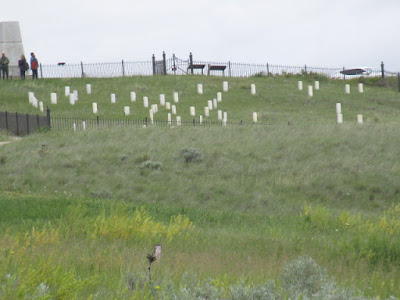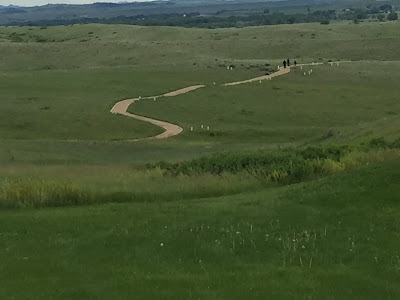Cody was our first stop after Yellowstone. It is on the gateway to the east entrance to Yellowstone. Since we were coming from West Yellowstone, we drove through the park, out the east entrance and through the canyon to Cody. This is one of the most scenic drives in the park and we had some of our best wildlife sightings on that road; coyote, deer, elk and a herd of goats walking right along the edge of the road!
Driving around Cody has its own share of wildlife.
There may be a leash law for dogs, but the deer come and go as they want!
Driving around Cody has its own share of wildlife.
There may be a leash law for dogs, but the deer come and go as they want!
Cody is located on the Shoshone River at the end of the Shoshone Canyon. Cody is named for one of it's earliest settlers, William F. Cody, a.k.a. Buffalo Bill. In the heart of town is the Buffalo Bill Center of the West Museum, a Smithsonian Affiliated museum. There were 5 museums in 1 building as well as a Research Library and 2 days were recommended to see it all. We spent one day there and only explored about half of it, but it was well worth it.
The Cody Dam was an amazing feat of "man over mountain", or in this case, Man over River. It took 5 years to build because of poor management and impossible working conditions. Each year work would progress until the rainy season would begin and inevitably wash away a section of the completed work. Three different companies attempted the project until one finally figured out how to complete it. At the time it was built (from 1905-1910) it was the highest dam in the world at 328 feet.
Another of our Wild West stops was at the Little Big Horn Battlefield National Monument in Montana.
The park guide was a history buff who told the story of Custer and Sitting Bull. By the time we got to Little Big Horn we were familiar with the story of the United States plan to move the Indians to Reservations and we had seen numerous places where different tribes had pushed back. The battle at Little Big Horn was between the Lakota, Cheyenne and the Federal Military Forces as the nomadic Indians resisted efforts to be confined to a reservation.
Most battlefields try to tell the story, but the open fields and waving grass leave the scene totally to your imagination. Little Big Horn was no different, except for one big change. At this battlefield there are markers where each soldier or Indian fell; white for an American soldier, and red for an Indian.
And if the person was important enough the marker was engraved with his name.
 It gives the battle a different feel when you see a single marker here, and another there, and then a big cluster of them in one spot where the furious fighting took place.
It gives the battle a different feel when you see a single marker here, and another there, and then a big cluster of them in one spot where the furious fighting took place.
Last Stand Hill is the site of Custer's Last Stand.
A beautiful Indian memorial commemorating their part in the battle is built into the hillside.
The Battlefield of Little Big Horn is also a national cemetery that until recently was still receiving burials.
Entering the Buffalo Bill Museum you meet the old pioneer in a hologram.
Known for his show, "The Buffalo Bill Wild West Show" Buffalo Bill became an American Folk Hero, but his beginnings were as a real participant in life in the old west. Bill began as a rider for the Pony Express, before he fought in the Civil War, was an army scout, and then a showman. 

Much of the displays in the Buffalo Bill Museum are dedicated to sharing the many facets of this man as well how his views changed as his experiences changed him.
He was a proponent of Women's Equality and the women (like Annie Oakley) that performed in his show were paid the same as the men.
There were also interactive displays like this one.
Another one pointed out the job of a wagon train or military scout and directed viewers to find signs that people or animals had traveled through an area.
 |
| There were several things for viewers to locate in this scene. |
In between his stints on the road with his show, which toured world-wide, he settled on a ranch in the Shoshone Canyon, and was responsible for much of the town's development. Among the things he is remembered for today, is the founding of the Irma Hotel in Cody, named for his daughter, as well as founding the newspaper that still serves the community of Cody. But perhaps the most important gift he gave the area was the land his ranch was on in order to build a dam on the river to provide water for the community, and irrigation for other ranches and farms. He was a leading proponent of the dam and although most thought a dam couldn't be built but he fought to see the project completed.
The Cody Dam was an amazing feat of "man over mountain", or in this case, Man over River. It took 5 years to build because of poor management and impossible working conditions. Each year work would progress until the rainy season would begin and inevitably wash away a section of the completed work. Three different companies attempted the project until one finally figured out how to complete it. At the time it was built (from 1905-1910) it was the highest dam in the world at 328 feet.
 |
| The Shoshone River runs between rugged cliffs |
 |
| The Reservoir now guarantees water for the farms, ranches and communities year round. |
The park guide was a history buff who told the story of Custer and Sitting Bull. By the time we got to Little Big Horn we were familiar with the story of the United States plan to move the Indians to Reservations and we had seen numerous places where different tribes had pushed back. The battle at Little Big Horn was between the Lakota, Cheyenne and the Federal Military Forces as the nomadic Indians resisted efforts to be confined to a reservation.
Most battlefields try to tell the story, but the open fields and waving grass leave the scene totally to your imagination. Little Big Horn was no different, except for one big change. At this battlefield there are markers where each soldier or Indian fell; white for an American soldier, and red for an Indian.
And if the person was important enough the marker was engraved with his name.
 It gives the battle a different feel when you see a single marker here, and another there, and then a big cluster of them in one spot where the furious fighting took place.
It gives the battle a different feel when you see a single marker here, and another there, and then a big cluster of them in one spot where the furious fighting took place. |
| Last Stand Hill |
 |
| Marker where Custer died |
 |
| Indian Memorial |
 |
| Indian Memorial |
The Battlefield of Little Big Horn is also a national cemetery that until recently was still receiving burials.
After seeing all of this western country, from Utah rocks and canyons, to prairies and battlefields, I will be viewing westerns and historical movies with a different eye, one that takes in the scenery .
has walked on those rocks and felt the wind blowing across the prairie. Sometimes the vastness of this land amazes me.
But we weren't done. Next installment; The Badlands of South Dakota!
But we weren't done. Next installment; The Badlands of South Dakota!





















